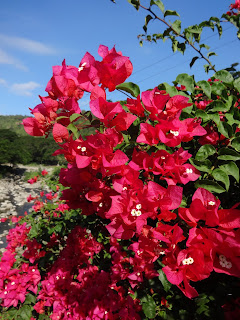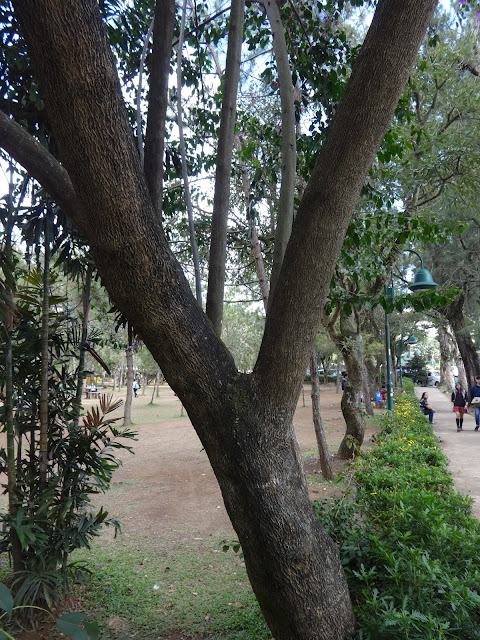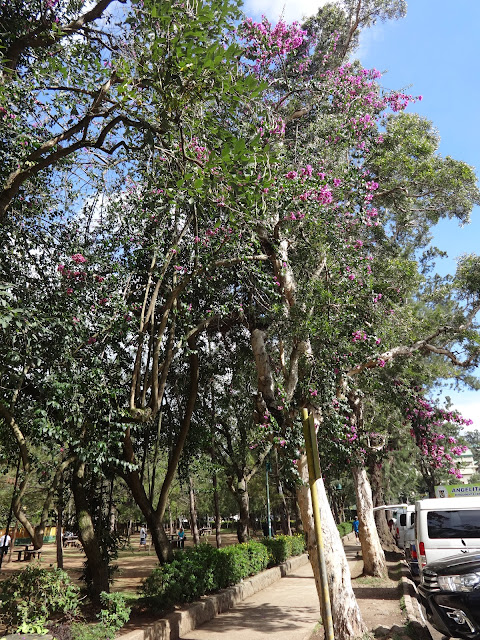 Polska wersja
Polska wersjaPLANT PROFILE
Bougainvillea spectabilis is a shrubby climbing perennial plant native to South America. Because of the astonishing beauty of it's flowers it has been distributed all around the world, grown in many gardens in warm regions and kept as houseplant wherever it is too cold. There are many cultivars of this plant, with inflorescence that are coming in many shades of red, pink, orange, golden, violet, magenta and pure white.
Botanists around the world are usually using names Bougainvillea spectabilis and Bougainvillea glabra for those charming ornamentals, with indication that first one is more robust and called Great Bougainvillea, while second grows smaller. But in reality it is hard to identify and segregate those hundreds of hybrids, in other order than by its flower's color. Only white varieties have always longer more oval leaves, most of the other have rather more or less heart shape.
Even though it was introduced to Europe around two hundreds years ago, and soon was spread around the world becoming one of most popular cultivated plants. It is still widely known only as an ornamental. Knowledge about it's medicinal values didn't spread that easily. Very few people are using it in India, Sri Lanka, and Malaysia, but only in South and Central America to Mexico, traditional use of this plant for healing has any popularity. In recent years there were quite few studies made in few different countries, conducted to test Bougainvillea medicinal values, that confirmed in laboratory tests it's healing powers. But that still didn't make it popular as a healing herb.
Its colorful inflorescence are sometimes used for dye.
Besides of many variations of name Bougainvillea, like: Buganvilea (Brasil), Bougainvillier (French), Bogambilia (Spanish), Booganbel (Hindi), Baganbilas (Bengali), Bongabilya (Tagalog). This plant is also commonly called : Paper Flower, Glory of the Garden, Cansarina, Ceboleiro, Juvu (Brasil), Tres-Marias (Portuguese), Santa Rita, Trinitaria (Spanish), Drillingsblume (German), Sekku-Pan (Burmese), Ye Zi Hua (Chinese), Kembang Kertas (Indonesia), Bunga Kertas (Malaysia), Shpupu-Kutshanat (Mexico), Fuengfa (Thai), Hoa Giay Nhan (Vietnam), Livetso (Congo), Ikada-kazura (Japan).
 CULTIVATION AND HARVESTING
CULTIVATION AND HARVESTINGBougainvillea spectabilis is a woody perennial plant with tendencies to climb. On its own it can create around 4m height wide bush with weeping branches. But when planted next to tall tree or with other type of support, it's stems can climb on it even up to 15m height. There are dwarf cultivars as well. It grows best in temperatures above 18'C, and dies when it is not much less than 0'C ( if your plant has been killed by frost, there is still chance that the roots survived, and it will sprout back when temperature will rise ). In regions with very dry season it often lose leaves and stay dormant till rains come. It flowers better when it has a bit of seasonal drought or chilly temperatures time, than when it is in all year round humid tropical area. It can have flood of flowers for around half of the year or even all year round (equatorial regions). It loves strong sun. It grows best on fertile, well watered and well drained soils but can cope even on poor dry sandy or clayish ground, and have high salt tolerance. If your plants are not making flowers or have just few, but have lush growth, it means it is overfed and over watered and you should starve it a bit. Bougainvillea should be propagated from cuttings to keep original color of flowers, as it crosspolinate easily, creating hybrids with new shades. It should be maintained with care as it's thorns, hiding under leaves, can have from 1 to 2 cm and can cause serious harm, but rare cultivars without thorns also can be found. It can be grown in containers and is cultivated as a house plant in cold climate regions. Many people are using its strong adaptation skills and toughness to turn it into beautiful bonsai.
Bougainvillea spectabilis leaf extract is highly effective in reducing yellow vein mosaic infection in okra and inhibited tomato spotted wilt and spovirus on capsicum annum, thanks to antiviral protein it contain. Methanolic extracts of flower bracts of Bougainvillea spectabilis are very good pH indicators.

CULINARY USES
Flowers of Bougainvillea are edible, it can be eaten fresh and have gently bitter taste, that gives feeling of refreshment. It is used in salads and drinks (violet flowers color drinks violet), including tea for coughs. It can also be turned into a snack, by frying whole flower clusters dipped in batter.
MEDICINAL USES
Bougainvillea has long tradition of medicinal use in south and central America and Mexico, that is very seldom known in India and other tropical countries where it is popular as an ornamental plant. All parts of plant including roots are used in forms of infusions (mostly flowers) decoctions (stems, leaves, roots) and tinctures (all parts). It is most commonly used as a tea for cough, sore throat, flu, fever, diarrhoea, and diabetes (it contain pinitol - chemical that is mimicking insulin). And is also used for hepatitis and liver problems (it protects liver thanks to esculetin content), asthma, bronchitis, to reduce stomach acidity, dissolve bloodcloths, to regulate menstruation and stop leucorrhea (white vaginal discharge), and for anemia associated with gastrointestinal bleeding and epigastric pain. Infusion from flowers is drunk as a remedy for low blood pressure.
 Even though nowadays cultivars of plants called Bougainvillea spectabilis, B. glabra and their hybrids, called Bougainvillea specto-glabra cannot be identified by differences in features. Scientists are usually unaware of that fact or too afraid to call them synonyms. In fact they just stick to spectabilis or glabra name that was passed to them from the source of the plant, without focusing on the most significant feature that differentiate those beautiful plants - flowers color. Sadly even in descriptions of plant material that was used in tests on bioactivity of Bougainvillea flowers, its color is mostly not mentioned. It is known though that violet, magenta and deep red colored flowers (more exactly flower bracts, that looks like petals) contains more healthy anthocyanins, than those brighter ones. It is obvious that like every herb, Bougainvillea spectabilis/glabra has many different chemotypes. But no matter which of those two names is on the title of research, it's results are always proving one medicinal pattern for Bougainvillea s/g stems and leaves, that contains : anthraquinones, saponins, triterpenoids, flavonoids, phenols, sterols, glycosides, alkaloids, tannins, furanoids, antiviral proteins, pinitol, esculetin, kaempferol, myricetin, quercetin, apigenin, rutin, sinapic acid, p-coumarin acid, p-hydroxy benzoic acid, ferulic acid, gallic acid, protocatechiuc acid, chlorogenic acid, vanillic acid, caffeic acid, oxalic and syringic acid.
Even though nowadays cultivars of plants called Bougainvillea spectabilis, B. glabra and their hybrids, called Bougainvillea specto-glabra cannot be identified by differences in features. Scientists are usually unaware of that fact or too afraid to call them synonyms. In fact they just stick to spectabilis or glabra name that was passed to them from the source of the plant, without focusing on the most significant feature that differentiate those beautiful plants - flowers color. Sadly even in descriptions of plant material that was used in tests on bioactivity of Bougainvillea flowers, its color is mostly not mentioned. It is known though that violet, magenta and deep red colored flowers (more exactly flower bracts, that looks like petals) contains more healthy anthocyanins, than those brighter ones. It is obvious that like every herb, Bougainvillea spectabilis/glabra has many different chemotypes. But no matter which of those two names is on the title of research, it's results are always proving one medicinal pattern for Bougainvillea s/g stems and leaves, that contains : anthraquinones, saponins, triterpenoids, flavonoids, phenols, sterols, glycosides, alkaloids, tannins, furanoids, antiviral proteins, pinitol, esculetin, kaempferol, myricetin, quercetin, apigenin, rutin, sinapic acid, p-coumarin acid, p-hydroxy benzoic acid, ferulic acid, gallic acid, protocatechiuc acid, chlorogenic acid, vanillic acid, caffeic acid, oxalic and syringic acid.As well as for it's confirmed actions : antioxidant, antidiabetic, anti-inflammatory, antipyretic, antidiarrhoeal, antiviral, antibacterial, antifungal, expectorant, antitumor (antiproliferate activity against several cancer cell lines), antithrombic, antiulcer, antiasthmatic, laxative, hepatoprotective, anti-atherogenic, nematicidal, larvicidal, analgesic, wound healing, antialergenic, antimutagenic and amylase inhibition.
In tests, water extracts significantly lower testosterone level in male, and estrogen in female mice. Alcohol extract reduces risk of cardiovascular diseases and reduces bad cholesterol level. Tests on effect of ethanolic extract of Bougenvillea leaves, showed it significantly reduces serum calcium and potassium and significantly increase phosphate concentration, serum urea and creatinine concentration. Therefore continuous usage of EEBSL might adversely affect normal functions of kidney and liver.

Sources
'' Edible Medicinal and Non Medicinal Plants : volume 8, Flowers '' - T. K. Lim, Springer Science & Business Media 2014
'' CRC World Dictionary of Medicinal and Poisonous Plants '' - Umberto Quattrocchi, CRC Press 2012
'' Medicinal Plants of the Borderlands '' - Antonio Noe Zavaleta, Ph. D., AuthorHouse 2012
'' Medicinal Plants in Australia Volume 4 - An Antipodean Apothecary '' - Cheryll Williams, Rosenberg Publishing 2013
'' Medicine in Mexico: From Aztec Herbs to Betatrons '' - Gordon Schendel, Jose Alvarez Amezquita, Miguel E. Bustamante, University of Texas Press 2014
'' Compedia of World's Medicinal Flora '' - Amritpal Singh, CRC Press 2006
http://www.stuartxchange.com/Bogambilya.html
http://www.ctahr.hawaii.edu/oc/freepubs/pdf/OF-38.pdf
http://www.researchgate.net/publication/230555463_Potential_health_enhancing_properties_of_edible_flowers_from_Thailand._Food_Res
http://tropical.theferns.info/viewtropical.php?id=Bougainvillea+spectabilis
http://chingchailah.blogspot.com/2014/11/bougainvillea-spectabilis-and-its-uses.html
https://en.wikipedia.org/wiki/Bougainvillea
http://arthurleej.com/p-o-m-Dec13.html
http://www.academicjournals.org/app/webroot/article/article1380561986_Ahmad%20et%20al.pdf
http://www.ipcbee.com/vol45/025-ICLSE2012-F20004.pdf
http://www.ijpsdr.com/pdf/vol3-issue2/14.pdf
http://www.hindawi.com/journals/ecam/2011/561625/
http://www.acgpubs.org/RNP/2009/Volume%203/Issue%201/27-RNP-0904-100.pdf
http://www.ijppsjournal.com/Vol4Suppl2/30.pdf
http://www.arjournals.org/index.php/ijpm/article/viewFile/651/500
http://apjtb.com/zz/2012s2/83.pdf
http://globalresearchonline.net/journalcontents/v34-1/31.pdf
http://saspublisher.com/wp-content/uploads/2013/08/SAJB-1372-75.pdf
http://www.rjpbcs.com/pdf/2012_3(3)/[65].pdf
http://jjnpp.com/?page=article&article_id=2322
http://scialert.net/fulltext/?doi=ajsr.2015.367.373&org=11
http://www.ijpsdr.com/pdf/evaluation_of_antifertility.pdf
http://www.phcogres.com/article.asp?issn=0974-8490;year=2015;volume=7;issue=1;spage=18;epage=22;aulast=Mandal
http://studentresearch.wcp.miamioh.edu/MedicinalPlants/MedPltsMexicoCultImpt-98.pdf
http://www.genesisjournals.org/data/Articles/Pharmagene/volume2/v2i32.pdf
http://journals.smu.edu.ph/wp-content/uploads/2015/07/Determination-of-the-Antioxidant-and-Phytochemical-Profiles-of-Flowers-from-Selected-Ornamental-Plants-within-Saint-Mary%E2%80%99s-University-Campus.pdf
http://www.academia.edu/4084715/Evaluation_of_thrombolytic_activity_of_Bougainvillea_spectabilis_leaf_extract
http://www.irjponline.com/admin/php/uploads/2208_pdf.pdf
http://farmacia.ugr.es/ars/pdf/384.pdf
http://flavorsofthesun.blogspot.com/2011/04/insanity-of-color-and-summery.html
http://www.nibblesandfeasts.com/2012/08/bougainvillea-and-champagne-grape-salad/
http://www.mitchryan23.com/bougainvillea-and-santan-flowers-for-snack/




























































































